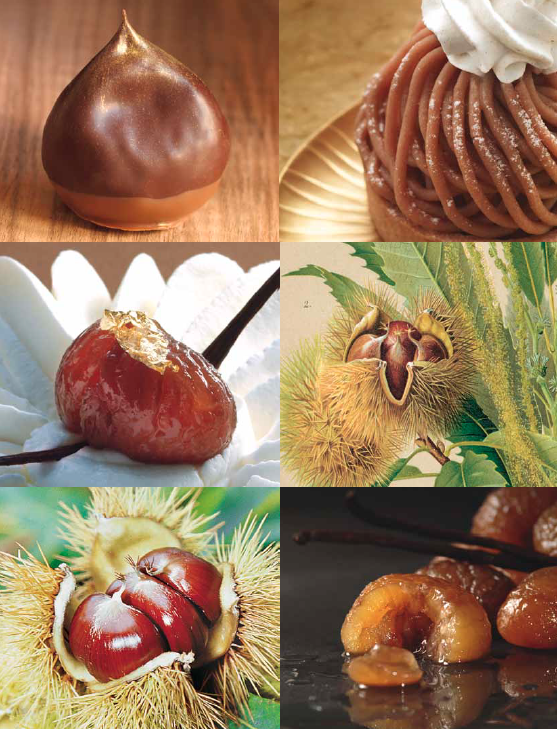ONCE UPON A TIME ...
All articlesThe chestnut
Glazed, these chestnuts!
For many years a poor person’s food, its encounter with sugar propelled the chestnut into the world of luxury, where it continues to captivate patisserie-makers, confectioners and food-lovers alike!
From a 21st-century perspective, it is difficult for us to imagine the dietary importance of the chestnut before the potato was discovered. In southern Europe where it grows spontaneously, the “bread tree” was found anywhere there was crystalline soil. However although they both bear the same fruit, the distinction was quickly made, according to size and appearance, between the “châtaigne” and “marron” forms; the first found huddled together in the same husk with at least two other chestnuts, the second with space to stretch out on its own. As food for the poor, it was used to prepare gruel-based meals such as the Corsican pulenda as a substitute for bread, which at the time was only eaten by the rich and used to prepare sophisticated dishes such as poultry stuffing or desserts. With sugar more affordable during the Renaissance, it is no surprise that attempts were made to produce a nobler, sweet version of them. In the mid 17th-century in France, La Varenne provided the first written recipe in the Parfait Confiturier. But perhaps they already existed in Italy? At that time, the country was renowned for its confectionary, and remains so for glazed chestnuts, particularly in the Piedmont region.

In France, the areas known for producing chestnuts used in patisserie and confectionary are the Ardèche region and the Maures Mountains in Provence. In Italy, the Piedmont and Naples regions produce good quality ones, imported for that matter by French confectioners due to the fact that the quality of the chestnut groves in France, neglected for many years, had deteriorated.
A fragile fruit in spite of its appearance, the chestnut is enclosed in triple casing: the husk with its prickles, the actual bark, and the tan, the final layer of skin so difficult to remove… All of which during the candying process calls for time-consuming and meticulous handiwork.
Wedged two by two in small muslin squares, the chestnuts are cooked in an autoclave before being crystallised, still in their swathes. After a lapse of time that varies according to the methods, the fruits bursting with vanilla-flavoured syrup are unwrapped and sorted again. Some will not have withstood the process, others, too hard, will never soften, or, too soft, will not keep well: all will end up as chestnut cream. The undamaged fruits are left a while before undergoing the glazing process: drained of their crystallising syrup, they are covered with a thin layer of another syrup and confectioners’ sugar then dried rapidly in the oven before being packaged. The basic preparations remain traditional, but in cream or glazed form, the chestnut still kindles the imagination of patisserie-makers.
Bénédict Beaugé
BRIEFLY
Laurent Le Daniel has just been named a Chevalier dans l’Ordre National du Mérite. Congratulations to him for this prestigious award, which rewards a passionate pastry chef very invested in the sustainability of his profession.
Prepare Valentine’s Day! Take the time to discover the chocolate or fruity sweets offered by our chefs for sale online. By ordering this week you will be delivered on time.
The French team is selected for the Pastry World Cup! She won the European Cup ahead of Italy and the United Kingdom who are also selected for the grand final in January at Sirha.
JOBS
Pâtisserie
La maison Zanin recrute pour son laboratoire de Sallanches un Second pâtissier en CDI – 39h. Toutes les informations ici !
Pâtisserie
La maison Ducobu, en Belgique, recrute sur différents postes. Toutes les informations ici.





